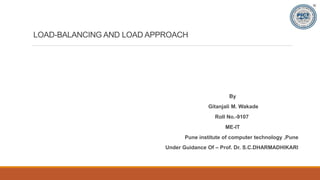Recommended
Recommended
More Related Content
Similar to AOS
Similar to AOS (20)
A SURVEY ON STATIC AND DYNAMIC LOAD BALANCING ALGORITHMS FOR DISTRIBUTED MULT...

A SURVEY ON STATIC AND DYNAMIC LOAD BALANCING ALGORITHMS FOR DISTRIBUTED MULT...
Modified Active Monitoring Load Balancing with Cloud Computing

Modified Active Monitoring Load Balancing with Cloud Computing
Coordinated Multi-Agent Control Utilizing Deep Reinforcement Learning

Coordinated Multi-Agent Control Utilizing Deep Reinforcement Learning
Development of a Suitable Load Balancing Strategy In Case Of a Cloud Computi...

Development of a Suitable Load Balancing Strategy In Case Of a Cloud Computi...
Dynamic Cloud Partitioning and Load Balancing in Cloud 

Dynamic Cloud Partitioning and Load Balancing in Cloud
IRJET - Efficient Load Balancing in a Distributed Environment

IRJET - Efficient Load Balancing in a Distributed Environment
Public Cloud Partition Using Load Status Evaluation and Cloud Division Rules

Public Cloud Partition Using Load Status Evaluation and Cloud Division Rules
AOS
- 1. LOAD-BALANCING AND LOAD APPROACH By Gitanjali M. Wakade Roll No.-9107 ME-IT Pune institute of computer technology ,Pune Under Guidance Of – Prof. Dr. S.C.DHARMADHIKARI
- 2. process scheduling techniques Task assignment approach ◦ User processes are collections of related tasks ◦ Tasks are scheduled to improve performance Load-balancing approach ◦ Tasks are distributed among nodes so as to equalize the workload of nodes of the system Load-sharing approach ◦ Simply attempts to avoid idle nodes while processes wait for being processed 2
- 3. 7 March 2001 CS-551, LECTURE 6 3 Load Balancing / Load Sharing Load Balancing ◦ Try to equalize loads ◦ Requires more information Load Sharing ◦ Avoid having an idle in system if there is work to do Anticipating Transfers ◦ Avoid system idle wait while a task is coming
- 4. 4 Types of Load Balancing Algorithms: Static Decisions are hard-wired in Dynamic Use static information to make decisions Overhead of keeping track of information Adaptive A type of dynamic algorithm May work differently at different loads
- 5. Load-balancing approach Fig : Load-Balancing Algorithms 5 Load-balancing algorithms DynamicStatic Deterministic Probabilistic Centralized Distributed Cooperative Non-cooperative
- 6. Load-balancing approach Type of load-balancing algorithms A. Static versus Dynamic ◦ Static algorithms use only information about the average behavior of the system ◦ Static algorithms ignore the current state or load of the nodes in the system ◦ Dynamic algorithms collect state information and react to system state if it changed ◦ Static algorithms are much more simpler ◦ Dynamic algorithms are able to give significantly better performance 6
- 7. Load-balancing approach B . Deterministic versus Probabilistic ◦ Deterministic algorithms use the information about the properties of the nodes and the characteristic of processes to be scheduled ◦ Probabilistic algorithms use information of static attributes of the system (e.g. number of nodes, processing capability, topology) to formulate simple process placement rules ◦ Deterministic approach is difficult to optimize ◦ Probabilistic approach has poor performance 7
- 8. Load-balancing approach C . Centralized versus Distributed ◦ Centralized approach collects information to server node and makes assignment decision ◦ Distributed approach contains entities to make decisions on a predefined set of nodes ◦ Centralized algorithms can make efficient decisions, have lower fault-tolerance ◦ Distributed algorithms avoid the bottleneck of collecting state information and react faster 8
- 9. Load-balancing approach D . Cooperative versus Non-cooperative ◦ In Non-cooperative algorithms entities act as autonomous ones and make scheduling decisions independently from other entities ◦ In Cooperative algorithms distributed entities cooperate with each other ◦ Cooperative algorithms are more complex and involve larger overhead ◦ Stability of Cooperative algorithms are better 9
- 10. 10 Fig 1: Load Balancing In Cloud Computing
- 11. 11
- 12. Issues in designing Load-balancing algorithms Load estimation policy ◦ determines how to estimate the workload of a node Process transfer policy ◦ determines whether to execute a process locally or remote State information exchange policy ◦ determines how to exchange load information among nodes Location policy ◦ determines to which node the transferable process should be sent Priority assignment policy ◦ determines the priority of execution of local and remote processes Migration limiting policy ◦ determines the total number of times a process can migrate 12
- 13. Transfer Policy Selection Policy Location Policy Information Policy Stability Sender-initiated versus Receiver-Initiated Symmetrically-Initiated Adaptive Algorithms 13 Load Distribution Algorithm Issues:
- 14. References: [1] “A STUDY ON LOAD BALANCING TECHNIQUES IN CLOUD COMPUTING ENVIRONMENT” International Journal of Engineering Research ISSN:2319-6890)(online),2347-5013(print) Volume No.5 Issue: Special 4, pp: 790- 991,20 May 2016 [2] “Load Balancing Techniques: Need, Objectives and Major Challenges in Cloud Computing- A Systematic Review “International Journal of Computer Applications (0975 – 8887) Volume 131 – No.18, December 2015 [3]Distributed Operating System : concept and Design by Pradeep K. Sinha 14
- 15. 15 Thank you for your attention!
